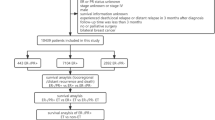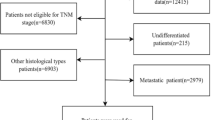Abstract
Purpose
Most breast cancer patients with estrogen receptor-negative/progesterone receptor-positive (ER−/PgR+) tumors are premenopausal cases, with few alternatives of adjuvant endocrine therapy but tamoxifen (TAM). The efficacy of adjuvant TAM on ER−/PgR+ patients is still controversial. In this study, we evaluated the efficacy of adjuvant TAM on patients with ER−/PgR+ tumors.
Methods
Among all 1,836 consecutive patients with operable primary breast cancer, 798 cases were with ER+/PgR+ tumors and 205 with ER−/PgR+ tumors. By sub-grouping the patients according to ER/PR phenotypes and whether the patients had been treated with adjuvant TAM therapy or not, we investigated the differences of survivals between groups.
Results
Patients with ER−/PgR+ tumors were younger than those with ER+/PgR+ tumors (P = 0.021), and were mainly premenopausal (P = 0.013). ER−/PgR+ patients were related to more involved lymph nodes and later stage. In the absence of TAM treatment, ER+/PgR+ group had a similar survival to ER−/PgR+ group in terms of 5-year disease-free survival (DFS), as well as overall survival (OS). After TAM treatment, both groups had increased survival rates comparing with the baseline of non-TAM-treated groups. Moreover, significant survival differences were then observed between TAM-treated ER+/PgR+ group and TAM-treated ER−/PgR+ group either in DFS (P = 0.016) or OS (P = 0.007). Of the TAM-treated patients, by sub-dividing the chemotherapy-treated population into CMF (cyclophosphamide, methotrexate and 5-fluorouracil) group and CA(E)F (cyclophosphamide, doxorubicin/epirubicin and 5-fluorouracil) group, we found that ER−/PgR+ group got more benefits from CMF regimen than from CA(E)F. Subpopulation treatment effect pattern plot (STEPP) analysis showed that the ER−/PgR+ group had an obvious worse survival than ER+/PgR+ group in younger patients (<55 years). Axillary lymph nodes involvement was the only independent prognostic factor for ER−/PgR+ group.
Conclusions
Our results indicate that patients with ER−/PgR+ tumors are mainly premenopausal and young. Although patients with ER−/PgR+ tumors are generally considered as candidates for endocrine therapy clinically, the ER−/PgR+ group gains less benefits from adjuvant TAM treatment than ER+/PgR+ group.




Similar content being viewed by others
References
Bernoux A, de Cremoux P, Laine-Bidron C, Martin EC, Asselain B, Magdelenat H (1998) Estrogen receptor negative and progesterone receptor positive primary breast cancer: pathological characteristics and clinical outcome. Institut Curie Breast Cancer Study Group. Breast Cancer Res Treat 49:219–225
Bezwoda WR, Esser JD, Dansey R, Kessel I, Lange M (1991) The value of estrogen and progesterone receptor determinations in advanced breast cancer. Estrogen receptor level but not progesterone receptor level correlates with response to tamoxifen. Cancer 68:867–872
Bonetti M, Gelber RD (2000) A graphical method to assess treatment-covariate interactions using the Cox model on subsets of the data. Stat Med 19:2595–2609
Borras M, Lacroix M, Legros N, Leclercq G (1997) Estrogen receptor-negative/progesterone receptor-positive Evsa-T mammary tumor cells: a model for assessing the biological property of this peculiar phenotype of breast cancers. Cancer Lett 120:23–30
Cui X, Schiff R, Arpino G, Osborne CK, Lee AV (2005) Biology of progesterone receptor loss in breast cancer and its implications for endocrine therapy. J Clin Oncol 23:7721–7735
Fanelli MA, Vargas-Roig LM, Gago FE, Tello O, Lucero De Angelis R, Ciocca DR (1996) Estrogen receptors, progesterone receptors, and cell proliferation in human breast cancer. Breast Cancer Res Treat 37:217–228
Goldhirsch A, Glick JH, Gelber RD, Coates AS, Thurlimann B, Senn HJ (2005) Meeting highlights: international expert consensus on the primary therapy of early breast cancer 2005. Ann Oncol 16:1569–1583
Grann VR, Troxel AB, Zojwalla NJ, Jacobson JS, Hershman D, Neugut AI (2005) Hormone receptor status and survival in a population-based cohort of patients with breast carcinoma. Cancer 103:2241–2251
Jonat W, Pritchard KI, Sainsbury R, Klijn JG (2006) Trends in endocrine therapy and chemotherapy for early breast cancer: a focus on the premenopausal patient. J Cancer Res Clin Oncol 132:275–286
Keshgegian AA (1994) Biochemically estrogen receptor-negative, progesterone receptor-positive breast carcinoma. Immunocytochemical hormone receptors and prognostic factors. Arch Pathol Lab Med 118:240–244
Keshgegian AA, Cnaan A (1996) Estrogen receptor-negative, progesterone receptor-positive breast carcinoma: poor clinical outcome. Arch Pathol Lab Med 120:970–973
Kiani J, Khan A, Khawar H, Shuaib F, Pervez S (2006) Estrogen receptor alpha-negative and progesterone receptor-positive breast cancer: lab error or real entity? Pathol Oncol Res 12:223–227
Levine L (2003) Tamoxifen stimulates arachidonic acid release from rat liver cells by an estrogen receptor-independent, non-genomic mechanism. BMC Cancer 3:24
Nikolic-Vukosavljevic D, Kanjer K, Neskovic-Konstantinovic Z, Vukotic D (2002) Natural history of estrogen receptor-negative, progesterone receptor-positive breast cancer. Int J Biol Markers 17:196–200
Osborne CK (1998a) Tamoxifen in the treatment of breast cancer. N Engl J Med 339:1609–1618
Osborne CK (1998b) Steroid hormone receptors in breast cancer management. Breast Cancer Res Treat 51:227–238
Shimada A, Kimura S, Abe K, Nagasaki K, Adachi I, Yamaguchi K, Suzuki M, Nakajima T, Miller LS (1985) Immunocytochemical staining of estrogen receptor in paraffin sections of human breast cancer by use of monoclonal antibody: comparison with that in frozen sections. Proc Natl Acad Sci USA 82:4803–4807
Winer EP, Hudis C, Burstein HJ, Wolff AC, Pritchard KI, Ingle JN, Chlebowski RT, Gelber R, Edge SB, Gralow J, Cobleigh MA, Mamounas EP, Goldstein LJ, Whelan TJ, Powles TJ, Bryant J, Perkins C, Perotti J, Braun S, Langer AS, Browman GP, Somerfield MR (2005) American Society of Clinical Oncology technology assessment on the use of aromatase inhibitors as adjuvant therapy for postmenopausal women with hormone receptor-positive breast cancer: status report 2004. J Clin Oncol 23:619–629
Yu KD, Di GH, Wu J, Lu JS, Shen KW, Shen ZZ, Shao ZM (2007a) Development and trends of Surgical Modalities for Breast Cancer in China: a review of 16-year data. Ann Surg Oncol 14:2502–2509
Yu KD, Liu GY, Di GH, Wu J, Lu JS, Shen KW, Shen ZZ, Shao ZM (2007b) Progesterone receptor status provides predictive value for adjuvant endocrine therapy in older estrogen receptor-positive breast cancer patients. Breast 16:307–315
Acknowledgment
This research was supported in part by the National Key Project of China (2001BA703BO5), and the grant from Shanghai Science and Technology Committee (06dj14004, 06DZ19504).
Author information
Authors and Affiliations
Corresponding author
Additional information
Yu Ke-da and Di Gen-hong have contributed equally to this work.
Electronic supplementary material
Below is the link to the electronic supplementary material.
Rights and permissions
About this article
Cite this article
Yu, Kd., Di, Gh., Wu, J. et al. Breast cancer patients with estrogen receptor-negative/progesterone receptor-positive tumors: being younger and getting less benefit from adjuvant tamoxifen treatment. J Cancer Res Clin Oncol 134, 1347–1354 (2008). https://doi.org/10.1007/s00432-008-0414-2
Received:
Accepted:
Published:
Issue Date:
DOI: https://doi.org/10.1007/s00432-008-0414-2




